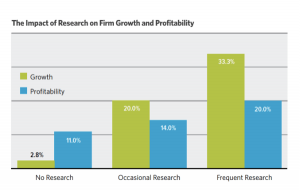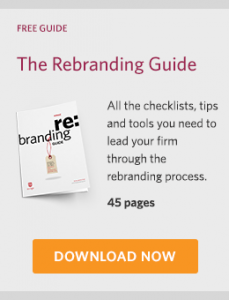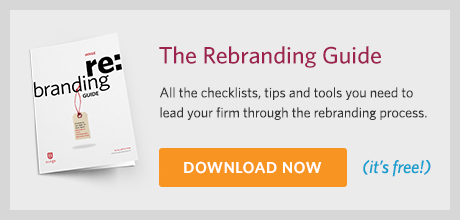We’ve written before on the importance of brand research. But today, I want to help you understand exactly how it gives your firm an advantage in the marketplace.
What specific points of leverage does a firm that conducts research have that it didn’t before? Let me begin by explaining what I mean by the term “brand research.” Brand research is a process that firms can use to measure their reputation and visibility in the marketplace. But it is more than a benchmarking tool. It also can help a firm understand how it is perceived by prospective clients and what untapped opportunities exist for growth.
Below is a little chart I love to show clients. It’s based on research Hinge did to reveal the relationship between research and business growth.

While firms that conduct frequent research correlate strongly with the highest levels of growth, those that do even modest levels of research tend to perform well above average. But what’s behind this relationship? How do brand insights turn into competitive advantage and growth?
Let’s check out some answers.
1. You’ll Know Where You Stand
Brand research can give you a clear picture of your marketplace. To be more specific, it can reveal how clients and prospects perceive your firm — and how they see your competitors.
If your research partner has compiled data on your industry, they may be able to benchmark your results against firms similar to yours. That means you’ll be able to compare your practice to competitors across a range of metrics. This knowledge is useful because it will give you a read on the health of your marketing — where you are strong and which parts of the business need work.
Here’s a key point. Having empirical evidence, untainted by your team’s natural biases and assumptions, is so important. It gives you the tools to make critical strategic decisions, such as how to position your firm (more on this in a moment) and where to put your limited marketing dollars.

At Hinge, we use brand research to measure a client’s brand strength. This metric consists of two components: 1) visibility, and 2) reputation.
Naturally, a firm that scores well in both of these categories has a strong brand. It is both well-known and highly regarded. Now, if you have a great reputation among your clients but low visibility, you know right away where you need to focus your resources — on activities that make you better known in the marketplace. If you have good visibility but a low reputation, you may need to work on operational aspects of your business, such as client service, quality assurance and training.
Research exposes a host of other invaluable insights, as well. For instance, our clients almost always discover that buyers in their market identify a very different set of competitors than they do, themselves. On average, there is only a 25% overlap between the two lists. That means you probably have no clue whom you are really competing against. Research can heal that blindness.
2. Adjust Your Positioning
Perhaps the most powerful thing you can do with brand research is assess and adjust your positioning. If you have never done brand research before, chances are you’ll be positioning your firm for the first time — and what a tremendous difference it can make!
Taking your firm through a differentiation and positioning exercise will give you a whole new way of talking about and selling your services. Finally, you will have a compelling story to tell about your firm, one that separates you from the rest of the crowd.
You may even find yourself compelled to make changes that sharpen your advantages. For example, you might specialize in a particular area of strength. If you have positioned your firm in the past, brand research allows you to reassess your differentiators and positioning. Is everything airtight? Or do you need to adjust to changes in the marketplace?
It’s not unusual, for example, for a new competitor to emerge that challenges your positioning. You may need to address the challenger head-on, ignore them if you determine the challenger poses little threat, or reposition your firm. Just like everything-marketing, you’ll want to consistently measure and adjust to stay on target – which takes us to…
3. Discover How Clients’ Needs Have Changed
It’s just common sense: the more you know about your clients and what specific services they need, the better you can serve them. And yet firms can be remarkably out of touch with the marketplace.
Clients’ preferences change, new pressures arise, unexpected threats appear on the horizon. But many service firms assume that it’s always sunny in Client Land.
Since many professional services firms don’t do any regular brand or market research, they often don’t notice gathering clouds. Brand research provides an opportunity to get a weather report on your target audiences. How’s the economy affecting the industry? What’s their biggest fear? What services would do they most want right now? How about six months from now?
Monitoring issues like these can give you a tangible advantage over competitors. You’ll have the intel you need to calibrate your messaging and services to the conditions on the ground.
4. Learn What Your Target Audience Looks for in a Firm
Pretend for a moment to close your eyes. What if you could know what clients were looking for when searching for a new firm? And what if you knew what factors would tip a tight, competitive bid in your favor?
Would you have an unfair advantage? Sure you would. And brand research can answer these very questions. When we conduct research for our clients, we ask their clients and prospects a series of questions designed to unwrap the mysteries around firm selection. Their answers provide a blueprint you can use to retool your firm — to become a sort of platonic ideal of a professional services firm.
In our own client research, we find common themes across engagements — most buyers are looking for specialized expertise and a good reputation, for instance — but the details vary greatly from market to market. Brand research will uncover competitive gems all your own.
[bctt tweet=”Research is only as good as what you do with it” username=”HingeMarketing”]
Brand research can be rich with insights, but you have to act on them to reap the benefits. And this is where many firms fall down. They become paralyzed by the possibilities, or they simply don’t get around to making the changes they need to act on the information. If you firm is serious about growth, you need great intel about your brand and your target clients. But your team also needs to be prepared for change.
A certain flexibility — a willingness to adapt as circumstances evolve — is a hallmark of long-term business success.
Additional Resources:
- Want to learn more? Our Professional Services Guide to Research will show you how to use research to build a smarter, more competitive firm.
- To understand how professional services buyers think and why they choose one firm over another, check out our 150-page book, Inside the Buyer’s Brain: How to Turn Buyers into Believers.
- Do you need to learn specific marketing skills? Or are you looking to bring data-driven marketing to your firm? Hinge University offers everything your need — from step-by-step how-tos to in-depth courses — at a very affordable price.
How Hinge Can Help:
For professional services firms that wish to accelerate growth or update their brands, success is within reach. Hinge is the leader in brand research services for professional services firms. With over 16,000 firms in our database, we benchmark you against your competitors and offer unparalleled actionable insights. Check out our industry-leading, research-based services or call us today: 703-391-8870.


